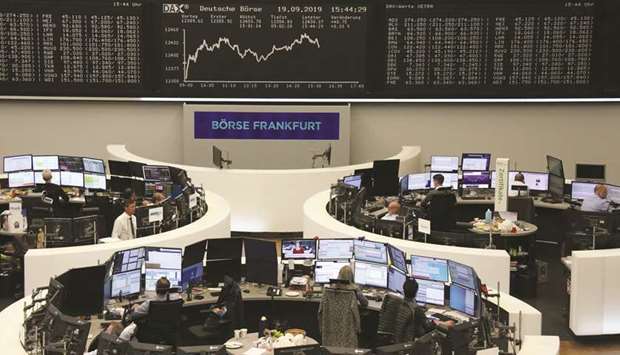Oil prices shot higher yesterday on fresh supply concerns in the Middle East, while stocks climbed on the US Federal Reserve’s decision to cut interest rates.
Brent oil jumped nearly over 1.5% as traders seized on resurfacing tensions in the crude-rich Middle East.
The market had surged at the start of the week after drone attacks at Saudi oil facilities on Saturday.
Traders remain on red alert for further developments, including the US and Saudi response, with both putting the blame at Iran’s door.
“There’s been a fairly sharp move higher in oil after a couple of incidents occurred in a short space of time that threaten to raise supply fears in the Middle East,” XTB analyst David Cheetham told AFP.
“First off, reports that Saudi Arabia will look to import oil to offset its own reduced production suggests that the impact of last weekend’s attacks is greater than the kingdom is letting on, with hopes of a swift return to the prior level of output looking hopeful to say the least.
“Not long after this, the Iranian foreign minister tweeted an inflammatory statement aimed at Saudi Arabia and together these have seen a flurry of buying in the oil price,” Cheetham added.
The crisis has reignited worries about a military flare-up in the oil-rich Gulf region, which would send prices soaring and likely hit stock markets.
CMC Markets analyst David Madden added that Riyadh did not want to lose precious market share.
“Saudi Arabia does not want its business going elsewhere, so it plans to import energy, and presumably resell it as a way of maintaining its business links,” Madden said.
“No doubt other energy producers see Saudi Arabia’s difficulty as their opportunity.”
In the eurozone, the Frankfurt and Paris stock markets gained on the Fed news and after increases across much of Asia.
In Europe, London’s FTSE 100 was up 0.6% to 7,356.42 points, Frankfurt’s DAX 30 rose 0.6% to 12,457.70 and Paris’s CAC 40 gained 0.7% to 5,659.08 points at close yesterday.
“European equity markets are higher...even though the Federal Reserve was not overly dovish,” said Madden.
“The US central bank cut interest rates by 0.25 %, meeting expectations, but the message from the update suggested that further rate cuts are not definitely in the pipeline.”
While the Fed met expectations with a 25-basis-point reduction, the lack of strong forward guidance disappointed many.
However, lower interest rates tend to support stock markets because they cut the cost of credit for businesses and loan repayments for consumers.
“Easier policy in absolute terms is good for stocks as it means lower rates, lower cost of capital, high bond prices and so pushes investors up the risk curve,” noted Neil Wilson at Markets.com.
London stocks also moved higher after the Bank of England, as expected, held its main interest rate steady at 0.75 %.
Investors shrugged off official data showing that UK retail sales dipped 0.2% in August from July.
“Following the BoE’s policy announcement earlier, which was deemed to be more dovish than anticipated, the pound dropped and this helped to lift the FTSE to a fresh high for the week,” said market analyst Fawad Razaqzada at Forex.com.
Wall Street stocks opened modestly higher.
Meanwhile, the pound edged higher yesterday after the bank of England kept policy rates unchanged, as widely expected, with broad dollar weakness lifting the British currency slightly.
All nine members of the BoE’s Monetary Policy Committee voted to keep rates on hold at 0.75% and reiterated their warnings that exiting the European Union without a deal risked hitting sterling and damaging growth.
“The Bank of England is pretty much on hold until there is a clear decision on Brexit and they were less upbeat on their growth and inflation forecasts as well,” said Morten Lund, a senior FX strategist at Danske bank.
Against the dollar, the pound floated 0.1% higher at $1.2482 after briefly falling to the day’s lows at $1.2448 following the central bank rate decision.
Britain’s economy unexpectedly shrank by 0.2% in the three months to June. Yesterday, the BoE said its staff now predicted a small bounceback of 0.2% in the three months to September, compared with the 0.3% it predicted six weeks ago.
Newsflow on the Brexit front was also not supportive of the pound.
Britain said yesterday it had shared documents with Brussels setting out ideas for a Brexit deal, but an EU diplomat described them as a “smokescreen” that would not prevent a disorderly exit on the October 31 divorce date.
Derivative markets signalled a pick-up in expectations of swings in the pound in the coming weeks, with one- and two-month volatility gauges spiking higher yesterday.

The German share price index DAX graph is seen at the Frankfurt Stock Exchange. The DAX 30 rose 0.6% to 12,457.70 points yesterday on the US Federal Reserve’s decision to cut interest rates.


